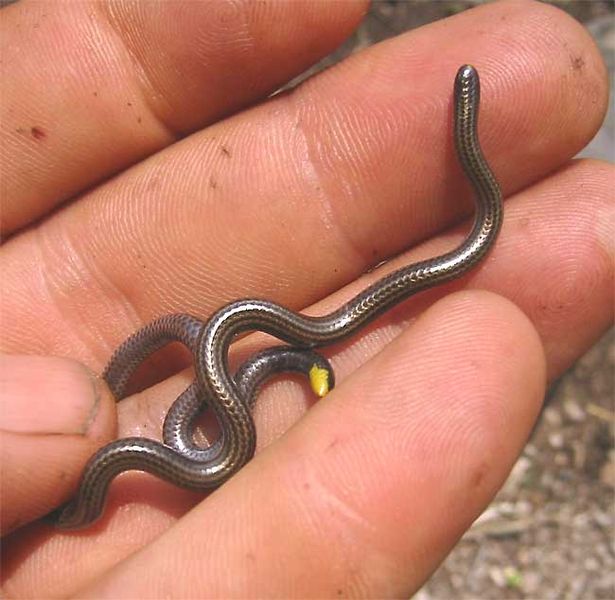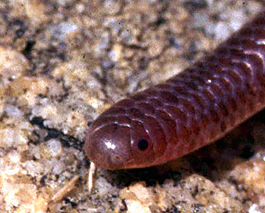
![]()
Since evolution is an inherently aimless process, it often seems fickle and prone to “changing its mind”. Vertebrates came out of the oceans only to return as icthyosaurs, mosasaurs, whales, and seals. Birds took wing only to get grounded as ostriches and auks. And snakes, whose long-ago ancestor (who was also the common ancestor of all vertebrates, including us) was probably some sort of tiny, wormy, spinal-corded thing, returned to a vermicular lifestyle after a fish/amphbian/legged reptile interlude. But there is a class of snakes that went above and beyond the call in returning to worm form. These would be the blind or thread snakes, the scolecophidians. You might think of them as the fish bait snakes.
These snakes seem to have evolved to capitalize on the veritable all-you-can-eat buffet of ant and termite larvae in the soils of many desserts and steppes. Though they’re thin as earthworms and only a few inches long, that’s more than enough, evidently, to tackle the teeming hordes of these nests. It’s as if someone released the sandworms of Dune on the planet of Aliens, but they all took a swig out of the “Drink Me” bottle. And someone made the sandworms cute:

Another organism seemingly designed by the Japanese! As you can see, blind snakes are not truly blind. They have two eye spots they can use to get an idea of where the big yellow hot thing is, roughly speaking.
And can these guys ever burrow. Leptotyphlops humilis, the western blind snake that inhabits my little corner of the world, has been found cruising around as deep as 66 feet underground. These organisms have several interesting strategies for gettin’ ‘er done, including a thick skull (! — this thing has a skull?) selected for burrowing and a spined tail they can use to gain leverage in their ant and termite colony-pillaging operations. When they find their prey, the suck out the hemolymphy, creamy centers and leave the exoskeletons or shells behind.
Scientists recently discovered and reported in Biology Letters that a particular subgroup — the blind snakes — somehow made it to from Africa to South America tens of millions of years after the splitting of the two continents and *without* using any frequent flier miles. Wha?
To figure this out, the scientists used the sequences of five genes to compare the differences and thus gauge relatedness between blind and thread snakes. They they used a molecular clock (an occasionally dodgy timepiece that gauges time based on number of accumulated mutations in coding genes) to estimate the time since different blind snake species shared a last common ancestor.
Some diversification was due (unsurprisingly) to continental drift: the ancestors of the threadsnakes were marooned on West Gondwana and the blindsnakes on East Gondwana and diversified accordingly. There seem to have been further splits in the blind snake lineage when India separated from Madagascar.
But their data yielded the further surprising result that the blindsnakes must have dispersed across oceans on at least three occasions: 28 million years ago from southeast Asia to Australia, 33 million years ago from South America to the West Indies, and 63 million years ago — incredibly — across the Atlantic Ocean, some 40 million years after Africa began to split from South America (ca. 100 million years ago). OK, now getting from Southeast Asia to Australia doesn’t seem so bad, and maybe one can see how they could manage the South America to Caribbean trip. But Africa to South America? Now it’s true that 63 mya sea levels were lower then and the Africa and South America much closer together. But the scientists still estimate the trip by blindsnake would still have taken as much as six months. Six months!
K. So it’s a blind snake. It has no legs, wings, fins, or reasonably functional eyes. How the heck did it accomplish what it takes humans with, at the very least, a row boat, a GPS device, half a million calories freeze-dried food, and several months of blog-documented travel to accomplish? Well, if you’re small, don’t really need to eat much or row, have packed along your food supply, and you have millions of years for just one blind snake ark to finally reach the promised land, odds are it will happen.
Scientists refer to the actual vehicles of dispersal as “rafts”. You might think of them more like floating terrariums, but what exactly were they? Were they pieces of soil and moss that happened to float? A rotting, termite-infested but still mighty tree? A Princess Cruise Ship? The ever popular African Swallow/coconut combo? Who knows. One way or another, the S.S. Scolecophidea made the Atlantic crossing.
Take home message from scientists: Even species that are total landlubbers (even landdwellers) can fire up a sea chanty when the right cruise opportunity presents itself.
Vidal, N., Marin, J., Morini, M., Donnellan, S., Branch, W., Thomas, R., Vences, M., Wynn, A., Cruaud, C., & Blair Hedges, S. (2010). Blindsnake evolutionary tree reveals long history on Gondwana Biology Letters DOI: 10.1098/rsbl.2010.0220


{ 1 trackback }
{ 3 comments… read them below or add one }
What are the chances there are any tweets mentioning “Snakes that Became Worms and Discovered Yachting”? Seems unlikely.
Well, I checked said tweets out before approving the trackback and they do seem to be legit to me . . . I’ve certainly been wrong before though. : )
Well that topped out my heeby-jeeby quotient for the day!